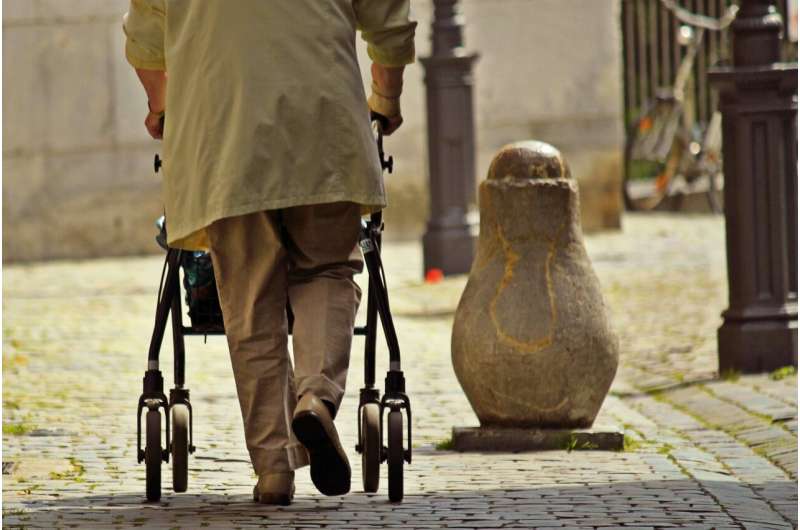This article has been reviewed according to Science X's editorial process and policies. Editors have highlighted the following attributes while ensuring the content's credibility:
fact-checked
trusted source
proofread
Factors that increase risk of frailty in old age are different in men and women, finds study

Older people with frailty syndrome should be prioritized in primary health care because they are more likely to suffer from falls, hospitalizations, incapacitation, and early death. The syndrome is characterized by the presence of three or more of the following factors: involuntary weight loss, fatigue, muscle weakness, slow gait, and a low level of physical activity.
A study conducted by researchers at the Federal University of São Carlos (UFSCar) in Brazil and University College London (UCL) in the United Kingdom found the factors that increase the risk of frailty in old age to be different in men and women. The results are reported in an article published in Archives of Gerontology and Geriatrics.
According to the results, osteoporosis, low weight, heart disease, and poor hearing increased the risk of frailty in men, while a high level of fibrinogen (a marker of cardiovascular disease) in the blood, diabetes, and stroke were associated with a higher risk of frailty in women.
The findings were based on an analysis of data from 1,747 participants in the English Longitudinal Study of Ageing (ELSA), an ongoing population survey that explores the dynamic relationships between health, functioning, social networks, and economic status in people aged 50 and over who reside in England. ELSA began in 2002. These participants were interviewed and assessed every four years between 2004 and 2016.
The researchers selected participants aged 60 or more who initially did not have frailty syndrome and were not classified as pre-frailty (with only one or two of the above factors).
"Frailty syndrome serves as a warning sign of the possibility of a negative outcome in an older person. We used to think of frailty as having a single pathway in the elderly, but our study shows there are several routes. The differences between men and women in this regard are important for policymakers to take into account."
"They should influence primary health care and could result in more gender-specific action plans and intervention for older people," said Tiago da Silva Alexandre, the last author of the article and a professor in UFSCar's Department of Gerontology.
Frailty syndrome has a phenotype, he explained—a set of easily identifiable signs and symptoms designed to identify older people with a heightened risk of falls, hospitalizations, incapacitation, and early death.
"Our study went back a few steps before this process begins to find out which characteristics may lead to frailty during the lives of these older people. When we think about aging and the quality of life in old age, it's very important to identify the main risk factors so as to be able to foresee problems and formulate public policy for men and women," he said.
The study derived from the Ph.D. research of Dayane Capra de Oliveira, conducted with Alexandre as thesis advisor. According to Oliveira, the first author of the article, although frailty, as a tool, is based on biology, sex-related differences in risk factors for the development of the syndrome are mainly associated with the different social roles of men and women and with their different degrees of access to resources during their lives.
"Another key aspect is that frailty is a multifactorial condition. While socioeconomic factors, skeletal muscle disorders, heart disease, and low weight appear to underlie frailty in men, in women, the process appears to be driven mainly by cardiovascular and neuroendocrine disturbances," Oliveira said.
It should be noted that frailty syndrome is more common in women than men, partly because of women's greater life expectancy. "This is a complex matter that has to do with the different life expectancies and the most prevalent diseases for men and women. Simply put, women are more affected by chronic diseases that aren't deadly but lead to disability. As a result, they live longer and can develop frailty syndrome more than men," Alexandre explained.
Differences and similarities
According to the researchers, while some risk factors for frailty are the same for men and women—including old age, low educational attainment, sedentarism, and depression, for example—differences in body composition and fat deposition throughout life and especially in old age may lead directly or indirectly to the appearance of components of frailty, such as metabolic alterations that culminate in the development of diseases, which in turn increase the risk of frailty.
"Our study is based on data for people now aged 60 or more and living in England. We don't know how these sex-based differences will play out in future generations. However, the fact is that the men in the cohort we studied were more exposed to several kinds of working conditions considered risk factors for diseases."
"Their diet was less healthy. They didn't go to the doctor as much as the women [so that there was less early diagnosis]. They drank more and were more exposed to other substances that increased the risk of cardiovascular disease and heart attack," Alexandre said.
Women are more affected by chronic diseases, which are not as lethal but can be incapacitating. "The sex-based differences are a lifelong backdrop and culminate in different aging processes, different causes of death or disability, and different kinds of frailty in men and women," he said.
More information: Dayane Capra de Oliveira et al, Does the incidence of frailty differ between men and women over time?, Archives of Gerontology and Geriatrics (2023). DOI: 10.1016/j.archger.2022.104880





















